Bogotá, Our Home
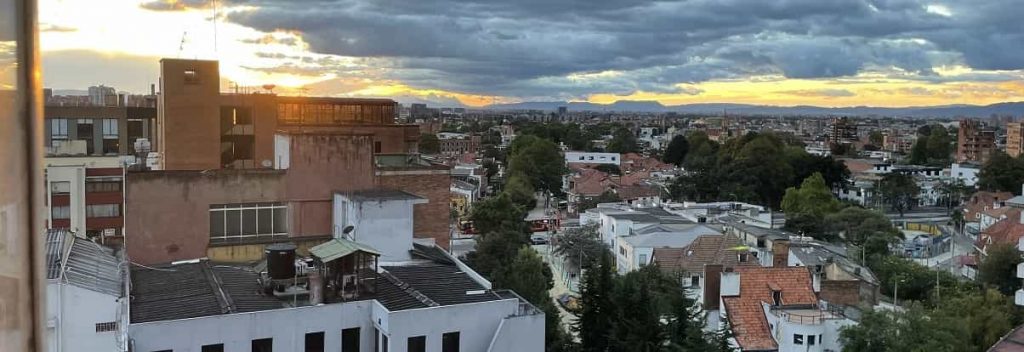
Justin Hauver
We arrived around midnight on a Thursday and took a cab to our hotel. At that hour, most of the shops we passed were closed and shuttered. The bright graffiti on their outer metal roll up doors made me think of an exhibit I saw a few years ago in México City that showcased the skill, creativity, and cultural roots embodied by the artworks that are painted onto its buildings, doors, and streets. I smiled and felt some of the vibrant energy that must drive and define Bogotá during waking hours.
The cab ride was another kind of introduction to Bogotá’s energy, as cab rides so often are. Abbey squeezed my hand tightly each time our driver made a quick or questionable move. He somehow managed to almost collide several times in nearly empty streets. The key word there is “almost” because we did, luckily, arrive at our hotel, crawl into a comfy bed, and pass out after 22 hours in transit. After breakfast the next morning, we moved 2 miles away to our long-term AirBnB apartment in Teusaquillo. Over the last week or so we have been setting up our home in Bogotá and figuring out new routines for our lives here.
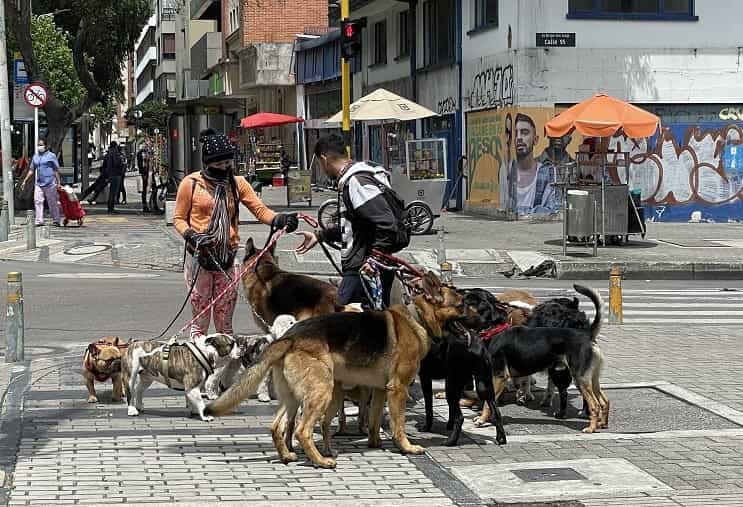
First Impressions
After a few days in our new home, we started to get a better feel for the culture and personality of the city. As Abbey pointed out, it does not have the “pura vida” exuberance of Costa Rica, nor do the people seem to have the immediate warmness of those we’ve interacted with in México. As the Fulbright Colombia handbook notes, “the inhabitants of colder regions, ‘tierra fría’, of Colombia are considered more formal, reserved and distant than those in warmer regions, ‘tierra caliente’, who are considered more open, relaxed and spontaneous.” In that sense, Bogotá feels a lot like many parts of big cities in the US where strangers are usually polite-ish but also a bit standoff-ish, at least in public spaces. Of course, neither of us have been to Bogotá, Colombia, or to any other part of South America before this, so it’s hard to know how much COVID-19 is shaping things. Everyone in public does wear a mask 100% of the time, even when walking down uncrowded streets or exercising away from big groups, so there is likely some extra distance between people nowadays.
In any case, we both agree that both Bogotá and rolos (bogotanos) grow on you. Everywhere we look we are met with beautiful vistas of sky, mountains, and city. It’s hard not to be charmed by that after a while. The people are also extremely helpful, from the person that yelled out of a car when I didn’t see that I had dropped my wallet to the women who have helped Abbey navigate the bus system to the market vendors who offered us free samples of interesting fruits. In Bogotá, being “reserved” or “distant” doesn’t imply being unfriendly or unkind, which is something I think (hope) is true of me as well!
More generally, thinking about Bogotá brings me back to David Bushnell’s point that in Colombian history, pretty much anything “is subject to negotiation and indeed was negotiated…” Negotiation is core to the spirit of the city, which is after all a political and commercial center. This ethos plays out concretely as buses, cars, and bikes negotiate with one another and with those on foot. Moreover, the transit system, known as the Transmilenio, rather than effortlessly offering up its routes, must be negotiated, even by locals who can be seen frantically hopping from bus to bus when a station is closed without warning. Along the skyline there is another tense negotiation between architectural styles, eras, and Andean mountains. Above that, even the equatorial sun must negotiate with the tierra fría for control of the often overcast skies. And now we are a part of these larger processes as we work to establish routines and create a home in Bogotá.
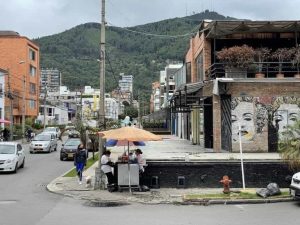
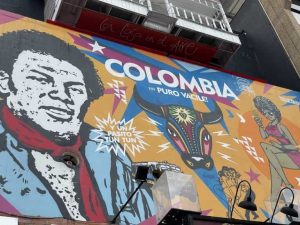
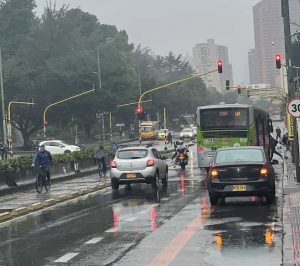
Creating a Home
Our apartment is well-located in one of Bogotá’s oldest neighborhoods, Teusaquillo. Within a few blocks there is a Transmilienio station, a large park, several stores and restaurants, a great gym, a wonderful coffee shop, and much more that we haven’t yet discovered. We are positioned roughly equidistant between more touristic areas within the larger downtown zone. A mile or three to the north there are several shopping malls, lively neighborhoods like Chapinero and El Chicó, and Abbey’s Spanish school. To the south we find La Candelaria, home to Bogotá’s old city center, the main federal government buildings, and a range of museums. It’s a very convenient place to live.
Aside from the cooking space, our apartment is pretty well set up. We have a smart TV, (finicky but mostly) hot water in the shower, and a solid internet connection. From the ninth floor, we also have an inspiring view of the city and, in the distance, mountains. Waking up to that each morning is an energizing infusion of the city’s vibes directly into our spirits. I’m writing this post from a desk looking out of that window as Abbey reads behind me, both of us basking in Bogotá’s lights and sounds. It’s our favorite part of the apartment.
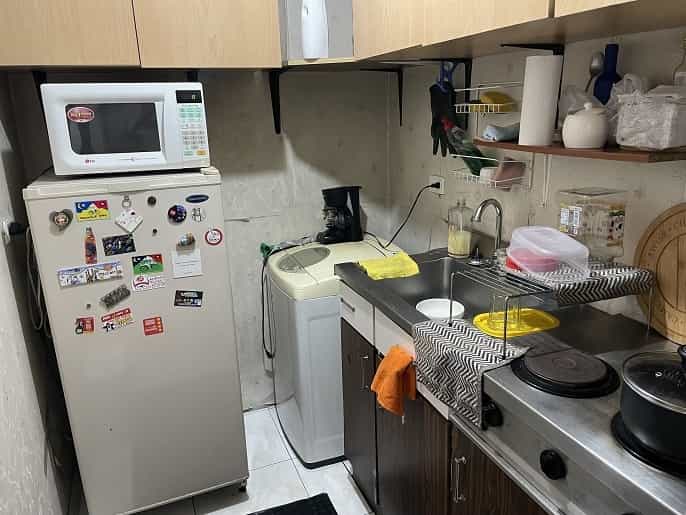
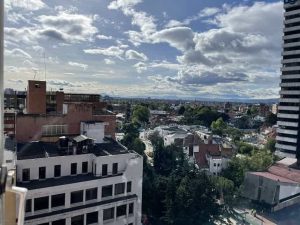
Finding Our Rhythm
After unpacking and poking around for a bit, we decided to figure out our neighborhood. We like to have a flexible weekly routine that includes grocery shopping, cooking, exercise, a restaurant meal or two, reading, and whatever other tasks we need to accomplish.
With an empty fridge and empty stomachs, our first priority was finding a supermarket. We found plenty within walking distance, chose one that looked like it had a large selection, and bought groceries and a few other things, like toiletries and such. Later in the week, Abbey found a nearby market, El Mercado Paloquemao, which we went to this past weekend. Though a bit overwhelming at first, el mercado won a place in our hearts and in our routine. Several vendors asked us when we planned to eat the fruit we were trying to buy and then helped us select pieces with just the right level of ripeness. Another offered us a free taste of a delicious fruit whose name we forgot and later had to google so that we could buy more of it on our next trip. In the back, we also found the most delicious tamales we’ve ever had: Tolima-style tamales filled with masa, potatoes, peas, chunks of meat, and Colombian magic. We’re excited to return to el mercado next weekend, continue learning the names of local fruit, and expand our palettes a bit.
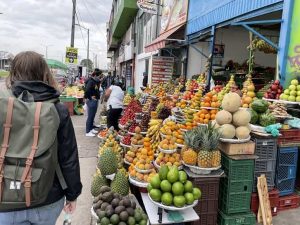

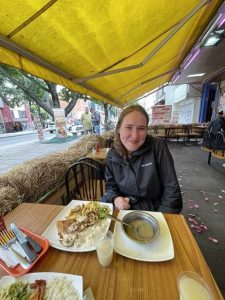
After getting our food situation squared away, we decided to try running at Bogotá’s altitude of 8,660 feet. We walked a block to El Parque Nacional and took off at a very slow pace that still managed to kick our butts. Sometimes walking too quickly from the living room to the bathroom can leave me winded, so it’s going to be a slow process of acclimatization. Luckily, we live in a good part of town for running, minus how high above sea level it is. Adjacent to the park is La Septima, a large boulevard that turns into La Ciclovia each Sunday and holiday. Bikers, walkers, and runners, all wearing masks, fill the street for miles in both directions, creating a community atmosphere that is perfect for our style of relaxed exercise. In addition to the running, I found a great gym nearby with a solid COVID protocol that has everyone social distancing, wearing masks, and carrying around bottles of disinfectant to clean the equipment before and after each use.
The last big task was figuring out the Transmilenio, which is Bogotá’s robust public bus system. The good news is that fares are really cheap (like 60 cents), there are a ton of routes that seem to go everywhere, and we are a short, 10-15 minute ride from places like Abbey’s Spanish school or the touristic sights in the old city center. The not so good news is that even those born in the city tell us that the system is confusing. It’s definitely too complex for Google, which had us waiting an hour for a bus line that does not exist. Even the more reliable Moovit app that we eventually downloaded doesn’t always take into account stations that might be closed for repair, cleaning, or protests. After some trial and error, and then some more error, we did eventually figure out quick and easy routes to and from Abbey’s Spanish school. Slowly we are expanding our knowledge of the system to other areas, like el mercado.
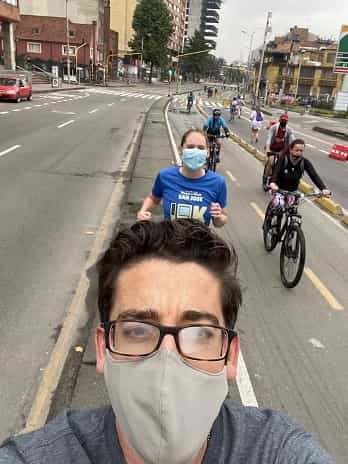

With those foundational pieces of our life in place, we have begun to develop a rhythm here. In the morning, we eat a croissant from the place across the street and drink some great Colombian coffee. Some days I go to the gym and other days I go for a run with Abbey. Then, Abbey goes to Spanish school for four hours while I meet with others virtually, practice my Spanish, do some reading, or write. We take a break in the afternoon and then do some more reading, writing, or studying in the evening.
Slowly, we have also been trying local foods from nearby restaurants and food stands. Arepas con queso and tamales tolimenses are already favorites. As is a nearby coffee shop, Varietale, which has a great outdoor space as well as delicious (mocha) cappuccinos and breakfast foods. We have, however, discovered a curious lack of well-baked, tasty chocolate treats, but Abbey has no problem trying out different desserts until we find something that hits the spot. More generally, with so many nearby restaurants and new types of food to try, we will be occupied for a while searching for special places
Looking Forward
So far we are doing pretty well in Bogotá. We both know and feel that it’s a huge privilege to be here and it’s wonderful to have so much time to pursue our interests at a leisurely pace. Abbey is consuming books at a rate not reached since her adolescence, before exhausting adult commitments like working a job put a squeeze on her free time. I’m making some progress with the very responsive and helpful folks at Fundación Escuela Nueva. I hope to make contact with teachers soon and maybe start observing learning spaces in August. We’ll see! In the meantime, I’m trying to improve my Spanish, practice this writing thing, learn more about Colombia, and enjoy this special time that we have together in Bogotá.
Note: All views expressed are my own, they do not represent the Fulbright or any other organization.